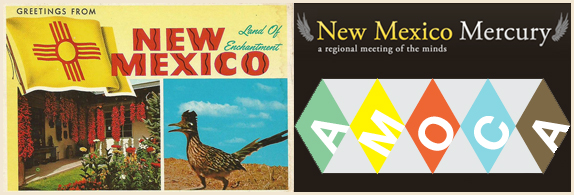The Collapse of Western Civilization

In a fictional essay “written” by a Chinese historian from the Second People’s Republic of China in 2300, scholars of the future are in a deep quandary trying to understand how “western civilization,” and its industrial and market forces based on science and its technological enterprises, could have destroyed itself by failing to respond to overwhelming scientific evidence that the earth’s climate was changing in a catastrophic way.
Authors Naomi Oreskes and Erik M. Conway invented the Chinese scholar of the future in their slender story called The Collapse of Western Civilization: A View from the Future, published this year by Columbia University Press. They are also the co-authors of the strongly argued book Merchants of Doubt: How a Handful of Scientists Obscured the Truth on Issues from Tobacco Smoke to Global Warming,” Bloomsbury Press, 2010.
In The Collapse of Western Civilization, the Chinese historian uses the term “Period of Penumbra” to describe the fatal decades of knowledge without action. It’s described in an appendix called a “Lexicon of Archaic Terms” as “The shadow period of anti-intellectualism that fell over the once-Enlightened techno-scientific nations of the Western world during the second half of the twentieth century, preventing them from acting on scientific knowledge available at the time and condemning their successors to the inundation and desertification of the late twenty-first and twenty-second centuries.”
Oreskes and Conway’s story is punctuated by graphics of coastlines in 2030. Virtually two thirds of Florida is gone, most of New York City is under water, and most of Bangladesh is submerged.
The Collapse of Western Civilization is one of those rare and prescient works of literature that reads so true to life that one might use it as a map to the nearby future, the next 100 years at least. It’s among the best analyses I’ve read of what’s gone on in the lifetime of many of us and what will continue on into the future for the rest of us -- who are left.
As the Chinese historian observes:
A key attribute of the….(Period of Penumbra) was that power did not reside in the hands of those who understood the climate system, but rather in political, economic, and social institutions that had a strong interest in maintaining the use of fossil fuels. Historians have labeled this system the carbon-combustion complex: a network of powerful industries comprising fossil fuel producers, industries that served energy companies (such as drilling and oil field service companies and large construction firms), manufacturers whose products relied on inexpensive energy (especially automobiles and aviation, but also aluminum and other forms of smelting and mineral processing), financial institutions that serviced their capital demands, and advertising, public relations and marketing firms who promoted their products.
And then the Chinese historian observed that while the carbon-combustion complex was making hay, and while non-carbon-combustion scientists were describing in minute detail the build-up of green-house gases and the increasingly probably catastrophic consequences, “a large part of Western society was rejecting that knowledge in favor of an empirically inadequate yet powerful ideological system. Even at the time, some recognized this system as a quasi-religious faith, hence the label market fundamentalism.”
The “market” was supposed to solve all problems, but the molecules of CO2 don’t listen to financial gossip. No large investor wanted to take the first step to risk guaranteed profits from government anointed fossil fuels by moving a “sure thing” speculation on alternative energy, especially since the government was only subsidizing Fukashima-tarnished nuclear energy and neglecting sizable subsidies and long term tax incentives for solar and wind power.
Market fundamentalism told investment managers everywhere that only pouring money into government backed oil and gas companies would meet their fiduciary obligations. The anti-government dogma of market fundamentalism didn’t apply to investments. It was OK to hate the government and take as much of its money as you could.
The Collapse of Western Civilization is so engrossing, so convincing, and so short that you’re left with an impression of historical inevitability that’s hard to shake. The Great Collapse of the West took place in 2093 after decades of misery, growing anarchy, displacement of vast numbers of people, and constant and intransigent denial of the cause of global warming and its remedy which is staring us all in the face.
This is a book I’m going to give to all my younger friends this Christmas. I don’t think it will depress them. But rather it will give them a sense of reality and purpose amid the smoke screens, mirages and delusions of the present political stupidity of calling climate change a “hoax” and denying the terrible impact of human technology and the use of fossil fuels on the climate and weather of the world.
As many New Mexicans enjoyed the gentle rains of last week, and sweltered though the heat of the weekend, we find ourselves living on the early edge of what the Chinese historian of 2300 calls the “desertification” of all of the American Southwest.
Some of us in deep drought conditions in southern New Mexico already know this prediction rings with truth. Let’s hope the rest of us won’t be among the families whose frail and vulnerable people suffer from heat stroke, like they have in the heat waves that struck southern Europe in 2003 and 2007. In 2003 more than 70,000 people died in Europe from heat related illnesses. They were mostly the very young, the very poor or the old and unwell.
Good Police Work

A tiny blotter report on page A-4 of the Journal last week revealed that APD officers don’t have to shoot and kill everyone who sets a threatening look in their direction. What happened on Easy NW is an example of good police work, a threatening situation in which no one was killed.
In an unsigned three paragraph “Journal Staff Reports,” we learn that an Albuquerque man who lives with his wife on Easy St NW threatened her with a bow and arrow then somehow “armed himself with a replica handgun to draw it on police.” The police arrived, the man told them the gun wasn’t real, and they arrested him for threatening his wife. They didn’t shoot him. I’m not sure yet if a SWAT team was there, or if other officers were present, or if video recorders were switched on.
The salient fact, however, is that no one died.
That little piece was almost like reading a story from the l960s. The cops came, calmed the situation, put people out of harms way, made a routine arrest and left with a suspect in custody. As they should have.
An incident like this could well have seen someone getting blown away given the APD’s trigger-happy history. But not this time. I don’t want to make too much of this, but cool heads prevailed. I don’t know if it’s a trend or not. But this situation was set up for a killing, and no one pulled the trigger. Thank goodness.
One can’t help but feel good about this.
Why Do We Love New Mexico?

This is the first of a long series of observations and opinions about New Mexico, this place we love and call home. Like all states in the union, we are a political entity with a constitution, a government, political parties, immigrant cultures, and a complicated economy. These all play a sometimes difficult, but always important, part in our lives. And like all states New Mexico is a physical landscape and a climate of weather upon which and in which people of various cultures reside. We have a fascinating history but so does everywhere else, more or less. We are distinguished by our founding cultures – Native American and Hispanic – which span centuries of vibrant life and the growing wisdom it takes to successfully adapt to a harsh environment.
So why is this place so deeply loved by so many? I won’t pretend to answer such a question directly, but rather indirectly. I’ll tell lots of stories and see what images they create.
I’ve been inspired to ask this question because of a piece we ran last week by Sarah Brooks called “A Love Letter to New Mexico.” It was suffused with such genuine affection and was so rich with the mystery of deep connection that it resonated with me on a very personal level. There must be thousands of reasons why I love New Mexico. I’ll start with two.
First, I don’t really think New Mexico Mercury could have been attempted anywhere but here, at least by Benito and me. Benito Aragon and V.B. Price are co-founders of the Mercury and their parent company New Lens Media, LLC. We’re two North Valley boys, one born and raised here, the other who wishes he had been but who’s spent 45 years at the same address in what used to be a semi-rural oasis of orchards and open fields a short hop from what’s now Matthew Meadows and just down from Valley High. Benito was a Valley High running back twenty or so years ago, and I’m sure I heard the Valley band practicing when Benito’s Vikings were hard at work on the field.
How the two of us met up is a kind of New Mexico miracle. After the Albuquerque Tribune folded in February 2008 a number of Tribune readers held a rally to see if they could brainstorm some ideas to get it back. I went and Benito did too. We didn’t know each other. That was six years ago. The rally was full of noble sentiments and great people, but the Trib had bit the dust – long live the Trib. I thought I’d really never write another column again after almost 35 years of meeting a deadline.
Then what turned out to be the disappointing on-line version of the New Mexico Independent appeared, and we both worked at the non-profit publication until the political strictures of being a 501-c3 crimped our styles and the Independent began to flounder with no discernable business plan. We’d met by then but still hadn’t really talked.
It was right about when the online Independent folded that Benito dropped me a line about a plan he had for an internet publication, complete with a solid business plan. We had coffee in the North Valley and talked and talked and planned and planned for almost four years.
We were in New Mexico. This sort of thing happens. A man in his mid-30s and a man in his early 70s can get together here in the spirit of the place and find age to be no barrier. Benito and I both graduated from UNM with degrees in cultural anthropology, albeit some 30s apart. Benito studied at USC too and eventually went to graduate school and earned a Masters in documentary videography from the University of Florida at Gainesville. I’d been writing and teaching in Albuquerque since the l960s, including stints at the “real” New Mexico Independent, Century Magazine which I co-founded with the Rini clan, editing New Mexico Magazine, publishing with UNM Press, and doing years of teaching in the UNM Honors Program.
We were, and are, a perfect fit. And, I’m tempted to say, only in New Mexico.
Benito’s genius with design, with videography, with in-depth reporting, with finding stories where other writers won’t look, with business organization and marketing, and with aggregation of news has made the New Mexico Mercury an essential daily read for a great many New Mexicans. Nothing in this enterprise happens without him.
The Mercury is 17 months in since start up and we’re still a two man team of North Valley boys, one 39, the other 73. The Mercury is thriving editorially against high odds. Our 10,000 plus unique viewers each month have come with almost no marketing on the strength of the quality of the writing and reporting of our staff and wonderfully gifted contributors, some 160 of them. I have to say it again, only in New Mexico.
It’s a phrase that applies in so many ways. A couple of roads and one art museum form another one of those quintessentially unique New Mexico experiences.
Roswell has become a favorite place to visit, not only because of Cahoon Park with its huge acorns, great walking environment, and water works, but also because of the Anderson Museum of Contemporary Art (AMOCA). The AMOCA is one of the great museums in a state filled with superb museum collections. Not a mile away from the New Mexico Military Institute, the AMOCA is housed in a handsome, peaked roof recycled industrial building and contains over 400 works of art largely from the Roswell Artists-in-Residence Program which started in l967 and has worked with many dozens of New Mexico artists. It’s nothing short of awe inspiring. Some have called the museum “the desert rose” of New Mexico. In a place normally associated with oil and aliens, finding this museum is not only a startling surprise, it’s also an excellent reason to return to Roswell year after year.
If you’re on such travels you might leave Roswell and drive south toward Artesia on NM 285. While the museum is lush with human genius, that highway is a shotgun road through one of the more boring and junked up landscapes in the state, punctuated here and there by what seem like derelict buildings, warning signs for a prison nearby and a field of dozens of junked or mothballed airliners. It feels to me like driving on an unfinished interstate a decade or so after the end of the world as we know it – and the exact opposite of the monument to the creative civilization of New Mexico that the AMOCA represents.
But perhaps you’re lucky enough to be on 285 to get to another road heading southwest in the direction of the Sacramento Mountains and beyond to the town of Alamogordo. To get there from 285, you turn onto New Mexico 13, also known as Sagebrush Valley Road, and rapidly find yourself on a supremely and magnificently empty back road 50 odd miles long and upon which you can enter into a New Mexico that is still as old and distant and tough as the state was in the early 19th century. It’s my nomination for one of the least traveled and most beautiful roads in the state. Sagebrush Valley Road moves you through huge tracks of ranchland and cactus, around beautiful distant canyons and up over a rolling landscape upon which you might see a couple of cows here and there and perhaps a cowboy tending them. Two or three dirt ranch roads lead off the two lane paved road going to spreads and homesteads hidden in folds of geology and time. And all the while as you drive, the island-like isolated range of the Sacramento Mountains grows closer and closer. If you love the High Alone, there’s hardly a more beautiful place in the world. And it’s one more of countless reasons to love New Mexico.
(Photo of police officer midsection by Jim Legans, Jr., New Mexico postcard from Noé Alfaro)

July 21, 2014